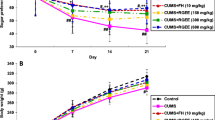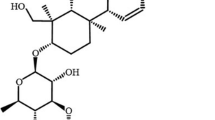Abstract
Gastrodin (GAS), a main constituent of a Chinese herbal medicine Tian ma, has been shown to be effective in treating various mood disorders. The purpose of the present study was to assess the effects of GAS on alleviating depressive-like behaviors in a rat model of chronic unpredictable stress (CUS) and regulating the expression of BDNF in the hippocampus and hippocampal-derived astrocyte from Sprague–Dawley (SD) rats. Following CUS, rats were intraperitoneally administered gastrodin (50, 100, or 200 mg/kg daily) or vehicle for 2 weeks. Rats were then experienced sucrose preference test and forced swim test. The expressions of GFAP and BDNF in the hippocampus were evaluated. In addition, hippocampal astrocytes were isolated from neonatal SD rats and exposed to different concentrations of GAS (sham, 5, 10, 20, 50 and 100 μg/mL) for 48 and 72 h before the cell viability and the levels of pERK1/2 and BDNF were analyzed. Furthermore, the cell viability was also tested after exposure to serum-free condition that contain different concentrations of GAS for 48 and 72 h. GAS administration (100 and 200 mg/kg daily) reversed depressive-like behaviors in rats exposed to CUS paradigm and restored the expression of GFAP and BDNF in the hippocampus. Moreover, in vitro experiments revealed that GAS did not increase the cell viability of astrocytes but protected it from 72 h’s serum-free damage at the dosage 20 μg/mL. Increased levels of ERK1/2 phosphorylation and BDNF protein were also observed after GAS (20 μg/mL) treatment for 72 h. These results indicate that gastrodin possesses antidepressant effect. The changes of the astrocyte activation and the level of BDNF may play a critical role in the pharmacological action of GAS.





Similar content being viewed by others
Abbreviations
- CUS:
-
Chronic unpredictable stress
- GAS:
-
Gastrodin
- BDNF:
-
Brain-derived neurotrophic factor
- FST:
-
Forced swim test
- GFAP:
-
Glial fibrillary acidic protein
- pERK1/2:
-
Phosphorylation extracellular regulated protein kinases
References
Gibson TB, Jing Y, Smith Carls G, Kim E, Bagalman JE, Burton WN, Tran QV, Pikalov A, Goetzel RZ (2010) Cost burden of treatment resistance in patients with depression. Am J Manag Care 16:370–377
Leucht C, Huhn M, Leucht S (2012) Amitriptyline versus placebo for major depressive disorder. Cochrane Database Syst Rev 12: CD009138
Murata A, Kanbayashi T, Shimizu T, Miura M (2012) Risk factors for drug nonadherence in antidepressant-treated patients and implications of pharmacist adherence instructions for adherence improvement. Patient Prefer Adherence 6:863–869
Berlim MT, Turecki G (2007) Definition, assessment, and staging of treatment-resistant refractory major depression: a review of current concepts and methods. Can J Psychiatry 52:46–54
Brent DA, Birmaher B (2006) Treatment-resistant depression in adolescents: recognition and management. Child Adolesc Psychiatr Clin N Am 15:1015–1034
Ojemann LM, Nelson WL, Shin DS, Rowe AO, Buchanan RA (2006) Tian ma, an ancient Chinese herb, offers new options for the treatment of epilepsy and other conditions. Epilepsy Behav 8:376–383
Lin LC, Chen YF, Lee WC, Wu YT, Tsai TH (2008) Pharmacokinetics of gastrodin and its metabolite p-hydroxybenzyl alcohol in rat blood, brain and bile by microdialysis coupled to LC-MS/MS. J Pharm Biomed Anal 48:909–917
Xu X, Lu Y, Bie X (2007) Protective effects of gastrodin on hypoxia-induced toxicity in primary cultures of rat cortical neurons. Planta Med 73:650–654
Zhao X, Zou Y, Xu H, Fan L, Guo H, Li X, Li G, Zhang X, Dong M (2012) Gastrodin protect primary cultured rat hippocampal neurons against amyloid-beta peptide-induced neurotoxicity via ERK1/2-Nrf2 pathway. Brain Res 1482:13–21
Zeng X, Zhang S, Zhang L, Zhang K, Zheng X (2006) A study of the neuroprotective effect of the phenolic glucoside gastrodin during cerebral ischemia in vivo and in vitro. Planta Med 72:1359–1365
Dai JN, Zong Y, Zhong LM, Li YM, Zhang W, Bian LG, Ai QL, Liu YD, Sun J, Lu D (2011) Gastrodin inhibits expression of inducible NO synthase, cyclooxygenase-2 and proinflammatory cytokines in cultured LPS-stimulated microglia via MAPK pathways. PLoS ONE 6:e21891
Jung JW, Yoon BH, Oh HR, Ahn JH, Kim SY, Park SY, Ryu JH (2006) Anxiolytic-like effects of Gastrodia elata and its phenolic constituents in mice. Biol Pharm Bull 29:261–265
Hsieh MT, Wu CR, Chen CF (1997) Gastrodin and p-hydroxybenzyl alcohol facilitate memory consolidation and retrieval, but not acquisition, on the passive avoidance task in rats. J Ethnopharmacol 56:45–54
Yong W, Xing TR, Wang S, Chen L, Hu P, Li CC, Wang HL, Wang M, Chen JT, Ruan DY (2009) Protective effects of gastrodin on lead-induced synaptic plasticity deficits in rat hippocampus. Planta Med 75:1112–1117
Sofroniew MV, Vinters HV (2010) Astrocytes: biology and pathology. Acta Neuropathol 119:7–35
Ridet JL, Malhotra SK, Privat A, Gage FH (1997) Reactive astrocytes: cellular and molecular cues to biological function. Trends Neurosci 20:570–577
Duman RS, Monteggia LM (2006) A neurotrophic model for stress-related mood disorders. Biol Psychiatry 59:1116–1127
Castren E, Voikar V, Rantamaki T (2007) Role of neurotrophic factors in depression. Curr Opin Pharmacol 7:18–21
Koo JW, Duman RS (2008) IL-1beta is an essential mediator of the antineurogenic and anhedonic effects of stress. Proc Natl Acad Sci U S A 105:751–756
Slattery DA, Cryan JF (2012) Using the rat forced swim test to assess antidepressant-like activity in rodents. Nat Protoc 7:1009–1014
Zhu H, Chen MF, Yu WJ, Wang WJ, Li F, Liu WC, Wo Y, Xia R, Ding WL (2012) Time-dependent changes in BDNF expression of pentylenetetrazole-induced hippocampal astrocytes in vitro. Brain Res 1439:1–6
Banasr M, Valentine GW, Li XY, Gourley SL, Taylor JR, Duman RS (2007) Chronic unpredictable stress decreases cell proliferation in the cerebral cortex of the adult rat. Biol Psychiatry 62:496–504
Anisman H, Matheson K (2005) Stress, depression, and anhedonia: caveats concerning animal models. Neurosci Biobehav Rev 29:525–546
Fellin T (2009) Communication between neurons and astrocytes: relevance to the modulation of synaptic and network activity. J Neurochem 108:533–544
Conti B, Maier R, Barr AM, Morale MC, Lu X, Sanna PP, Bilbe G, Hoyer D, Bartfai T (2007) Region-specific transcriptional changes following the three antidepressant treatments electro convulsive therapy, sleep deprivation and fluoxetine. Mol Psychiatry 12:167–189
Sillaber I, Panhuysen M, Henniger MS, Ohl F, Kuhne C, Putz B, Pohl T, Deussing JM, Paez-Pereda M, Holsboer F (2008) Profiling of behavioral changes and hippocampal gene expression in mice chronically treated with the SSRI paroxetine. Psychopharmacology 200:557–572
Allaman I, Fiumelli H, Magistretti PJ, Martin JL (2011) Fluoxetine regulates the expression of neurotrophic/growth factors and glucose metabolism in astrocytes. Psychopharmacology 216:75–84
Hisaoka K, Takebayashi M, Tsuchioka M, Maeda N, Nakata Y, Yamawaki S (2007) Antidepressants increase glial cell line-derived neurotrophic factor production through monoamine-independent activation of protein tyrosine kinase and extracellular signal-regulated kinase in glial cells. J Pharmacol Exp Ther 321:148–157
Deltheil T, Guiard BP, Cerdan J, David DJ, Tanaka KF, Reperant C, Guilloux JP, Coudore F, Hen R, Gardier AM (2008) Behavioral and serotonergic consequences of decreasing or increasing hippocampus brain-derived neurotrophic factor protein levels in mice. Neuropharmacology 55:1006–1014
Czubak A, Nowakowska E, Kus K, Burda K, Metelska J, Baer-Dubowska W, Cichocki M (2009) Influences of chronic venlafaxine, olanzapine and nicotine on the hippocampal and cortical concentrations of brain-derived neurotrophic factor (BDNF). Pharmacol Rep 61:1017–1023
Peng Q, Masuda N, Jiang M, Li Q, Zhao M, Ross CA, Duan W (2008) The antidepressant sertraline improves the phenotype, promotes neurogenesis and increases BDNF levels in the R6/2 Huntington’s disease mouse model. Exp Neurol 210:154–163
Shirayama Y, Chen AC, Nakagawa S, Russell DS, Duman RS (2002) Brain-derived neurotrophic factor produces antidepressant effects in behavioral models of depression. J Neurosci 22:3251–3261
Paizanis E, Renoir T, Lelievre V, Saurini F, Melfort M, Gabriel C, Barden N, Mocaer E, Hamon M, Lanfumey L (2010) Behavioural and neuroplastic effects of the new-generation antidepressant agomelatine compared to fluoxetine in glucocorticoid receptor-impaired mice. Int J Neuropsychopharmacol 13:759–774
Massa SM, Yang T, Xie Y, Shi J, Bilgen M, Joyce JN, Nehama D, Rajadas J, Longo FM (2010) Small molecule BDNF mimetics activate TrkB signaling and prevent neuronal degeneration in rodents. J Clin Invest 120:1774–1785
Duric V, Banasr M, Licznerski P, Schmidt HD, Stockmeier CA, Simen AA, Newton SS, Duman RS (2010) A negative regulator of MAP kinase causes depressive behavior. Nat Med 16:1328–1332
Di Benedetto B, Kuhn R, Nothdurfter C, Rein T, Wurst W, Rupprecht R (2012) N-desalkylquetiapine activates ERK1/2 to induce GDNF release in C6 glioma cells: a putative cellular mechanism for quetiapine as antidepressant. Neuropharmacology 62:209–216
Li B, Zhang S, Li M, Hertz L, Peng L (2009) Chronic treatment of astrocytes with therapeutically relevant fluoxetine concentrations enhances cPLA2 expression secondary to 5-HT2B-induced, transactivation-mediated ERK1/2 phosphorylation. Psychopharmacology 207:1–12
Acknowledgments
This work was supported by the National Natural Science Foundation (Grant no: 81201054, 81201041 and 81173285) of China and the Natural Science Foundation (Grant no: 2013JQ4014) of Shaanxi province.
Author information
Authors and Affiliations
Corresponding authors
Additional information
Ruiguo Zhang, Zhengwu Peng and Huaihai Wang have contributed equally to this work.
Rights and permissions
About this article
Cite this article
Zhang, R., Peng, Z., Wang, H. et al. Gastrodin Ameliorates Depressive-Like Behaviors and Up-Regulates the Expression of BDNF in the Hippocampus and Hippocampal-Derived Astrocyte of Rats. Neurochem Res 39, 172–179 (2014). https://doi.org/10.1007/s11064-013-1203-0
Received:
Revised:
Accepted:
Published:
Issue Date:
DOI: https://doi.org/10.1007/s11064-013-1203-0




